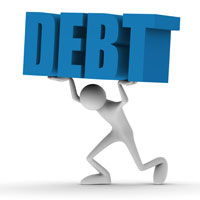 Many people have a general view of their financial situation and debt plays a major role in that picture. Acquiring debt is much like a bad semester in school. Mentally take off one semester and your grades plummet only to have to claw your way back to even after twice as long. Debt is much like this in that we can jump feet first into a new car or charge card while it takes years to climb out inch by inch.
Many people have a general view of their financial situation and debt plays a major role in that picture. Acquiring debt is much like a bad semester in school. Mentally take off one semester and your grades plummet only to have to claw your way back to even after twice as long. Debt is much like this in that we can jump feet first into a new car or charge card while it takes years to climb out inch by inch.
Debt comes in several packages that range from core debt to revolving Debt.
Core debt is the everyday sort that will always be with us as long as we want fresh water and clean sheets. These obligations can still cause consternation if not acquired properly. Many bankers told droves of new homeowners they could afford more house then they really could. 100% financing and interest only payment loans (ARM) have sent many to the poor house. Take your preapproval letter and see what percentage of your net income it equals. If it is more them 25% of your monthly income, then you may be on the wrong path.
Revolving debt usually refers charge card debt. This is debt that changes from month to month as people make purchases and make payments. It is therefore differentiated from the type of debt people have when they borrow a defined amount of money at a given time like for a personal loan or to buy a car or a house. The debt from these types of loans gradually decreases, and it is not possible to increase the debt without getting a new loan.
With things like charge card debt, people can choose to owe as much or as little as they want, up to the limit of the credit card. There generally is an upper limit amount on what people can owe, and limits are often determined by credit rating Those with excellent credit may be able to get high limit cards, but this doesn’t mean that the revolving debt amount has to be high. Instead, if people pay off all they owe on a card each month, the amount of debt is small, and can contribute to a good credit rating.
Another thing that can change with revolving debt is monthly payment owed. Most charge card companies set limits of a certain percentage of the debt that must be paid each month. If there is no debt then no payment may be due. When revolving debt remains from month to month, the debt amount carries over or revolves to the next month, and interest is charged on any debt that remains unpaid. In addition, amount of available credit goes up or down depending on the debt.


Leave A Comment